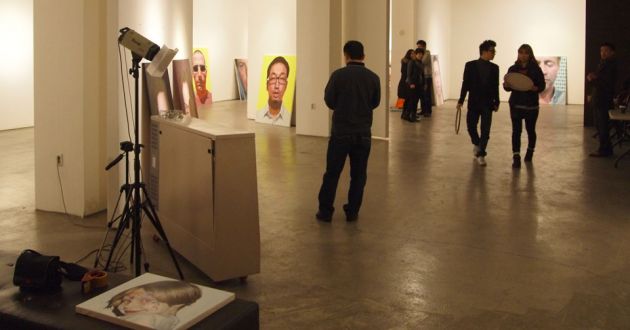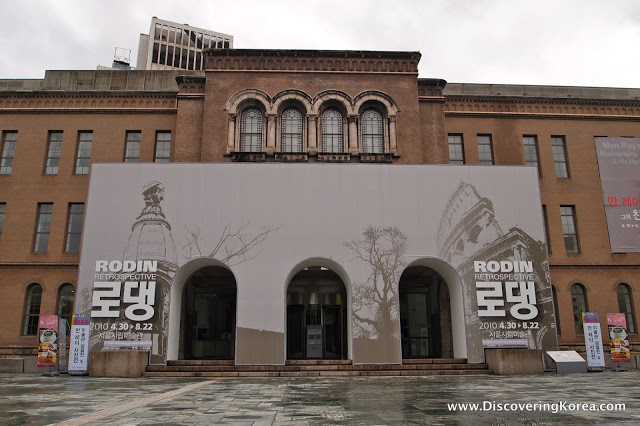Birds were a popular motif in Korean folk painting from the Joseon Dynasty (1392-1910). Pairs of cranes or geese symbolized a couple’s love and their hope for many children.

For these reasons, such art often adorned the home’s sleeping quarters. In turn, the house was built to reflect Confucian rules of social hierarchy and positioned to maximize auspicious energy.
Of course, this deliberate integration of art and architecture continues, as museums and galleries are built to complement their art.

While a museum’s greatness should be measured by the quality of its collection, ancillary concerns – like space, lighting or signage – can also play a role.
With this in mind, what follows are six examples of great Seoul art galleries and museums.
Arts Institutions
The Jeong-dong (정동) neighborhood’s cobblestone streets and brick buildings provide a glimpse into Seoul at the turn of the 20th century. Tree-lined walkways are enhanced by stone palace walls and clever public art.

Walking from City Hall Station towards the central rotary, benches resembling surfboards or the stacked black and white chips of the Korean board game, baduk offer respite.
Built in 1928, the Seoul Museum of Art (서울박물관) is located on an elevated patch of ground in Jeong-dong. The Romanesque-styled main building, its stone entrance and plaza exude authority and permanence.
Step inside, however, and natural light floods an airy space whose removable ceiling panels and white plaster walls reflect a temporality.

According to museum director Yoo Hee-Young, SeMA’s goal is to develop the public’s passion for great art through high profile offerings, like the current Marc Chagall retrospective (closes March 27).
The museum is certainly among the great Seoul art galleries and museums.
Seoul Museum of Art Information
| Open: | 10:00-21:00 (Mon-Fri), 10:00-19:00 (Sat-Sun), Closed Mondays |
| Admission Price: | ₩700 (more for special exhibits) |
| Address: | Seoul Jung-gu Seosomun-dong 37 |
| Directions: | City Hall Station (#201/#132) on Lines 1 & 2, Exit 1 |
| Phone: | Dasan Call Center: 02-120 |
| Website: | Official Site |
A very different public arts institution is the National Museum of Contemporary Art (국립현대박물관).
The museum is part of the sprawling grounds of Seoul Land, a quirky theme park in Gwacheon, Gyeonggi Province. Located beside rollercoasters and a recreated frontier village from the American Wild West, the museum’s setting confirms its mission to engage a broad section of the public.

Inside, playful architecture engages visitors.
For example, a deceptively narrow passage conceals the museum’s central Ramp Core, which features Paik Nam June’s epic “The More The Better” media installation.
Upon moving from the lobby into the Core, visitors are confronted by 1,003 televisions assembled into what resembles a 18.5-meter ziggurat. Situated at the center of an open atrium, a ramp winds the height of three stories affording visitors views of the sculpture from every angle.
Within the museum’s seven permanent galleries are other masters of Korean contemporary art, like Park Soo-keun and Pak No-soo, and lesser-known talents like Choi Ho-chul, whose “Euljiro Loop” depicts the humor and tension of urban life, as seen from a Seoul Metro subway car.
National Museum of Contemporary Art Information
| Open: | 10:00-18:00 (Tue-Fri); until 21:00 weekends |
| Admission Price: | ₩700 |
| Address: | Gyeonggi-do Gwacheon-si Makgye-dong |
| Directions: | Seoul Grand Park Station (#437) on Line 4, Exits 1-3 |
| Phone: | 02-2188-6000, 02-1566-3333 |
| Website: | Official Site |
Mission-Driven Galleries
Opened five years ago in upscale Sinsa-dong, Gallery LVS’s subterranean space has the airy and unfinished feel of a warehouse, with high ceilings and movable walls.
During preparations for an installation of portraits by Oh Su Jin and Hwang Jong Myung, CEO Judy Lee explained the simple rationale behind her gallery’s set up. “These days, young Asian artists want to make large-format art and we are one of the only places that can accommodate it.”

These days, large galleries tend to focus on old masters and Western artists. Furthermore, while an art gallery’s chief function is to sell art, the lethargic economy has over-saturated the market.
Yet, Lee’s passion is promoting young Asian artists and Gallery LVS is one of the few Seoul galleries that still does so. While not lucrative, Lee relies on her 25 years in the art market to help the next generation of struggling artists.
Gallery LVS Information
| Open: | 09:00-18:00 (Mon-Fri), 10:00-17:00 (Sat), Closed Sundays |
| Admission Price: | Free |
| Address: | Seoul Gangnam-gu Sinsa-dong 565-18 (Jasmi Building B1) |
| Directions: | Apgujeong Station (#336) on Line 3, Exit 4 |
| Phone: | 02-3443-7475 |
| Website: | Official Site |
A very different energy pervades Hakgojae Gallery (학고재), whose operating philosophy is “Create things new by mastering things ancient.”
This ethos is expressed in the gallery’s art as well as its construction – an elegant traditional hanok house is fused with a modern edifice of concrete and glass.

Inside, white walls separate thick wood beams and dark floors while passageways are filled with natural light.
Located across from the eastern wall of Gyeongbokgung palace (경복궁) , Hakgojae’s diverse exhibitions have featured Joseon-era calligraphy, the meditative photographs of Paris-based Kwon Boomoon and work by foreign artists, including Le Corbusier and Liu Xiaodong. Currently on display are the colorful paintings of Suh Yongsun (closes April 10).
Hakgojae Gallery Information
| Open: | 10:00-19:00 (Tue-Sat), 10:00-18:00 (Sun), Nov-Feb: 10:00-18:00 (Tue-Sat), Closed Mondays |
| Admission Price: | Free |
| Address: | Seoul Jongno-gu Sogyeok-dong 70 |
| Directions: | Anguk Station (#328) on Line 3, Exit 1 |
| Phone: | 02-720-1524 |
| Website: | Official Site |
Intimate Collections
Although many museums create impersonal, whitewashed spaces to avoid pre-empting the art, viewing art can create a sense of intimacy with the artist or the institution.
This is especially true at Musée Shuim (쉼박물관) in northern Seoul’s Hongji-dong neighborhood, where over 1,000 pieces of Korean folk art are displayed amongst the chandeliers, sumptuous drapes and dark wood floors of a stately home.

Named after two meanings of the Korean word for “rest” – from a cat nap to eternal sleep – the museum was inspired by the death of the founder’s husband.
According to chief curator, Lee Eui Jung, his passing inspired her aunt to assemble a one-of-a-kind collection of Korean traditional funerary art.
Today, the house features colorful palanquins, wooden figurines of humans, animals and goblins and a magnificent sangyeo, or hearse, from Jinju, South Gyeongsang Province.

Morbid by design, the pieces somehow convey a celebration of life as it honors the deceased. As an added attraction, the museum doesn’t take itself too seriously.
A group of figurines recreating the famous Korean folk opera Simcheongga is situated unceremoniously inside the bathtub.
Musée Shuim Information
| Open: | Summer: 10:00-18:00 (Mon-Sat), 14:00-19:00 (Sun); Winter: 10:00-17:00 (Mon-Sat), 14:00-19:00 (Sun) |
| Admission Price: | ₩7,000 |
| Address: | Seoul Jongno-gu Hongji-dong 36-20 |
| Directions: | Hongje Station (#324) on Line 3, Exit 1 |
| Phone: | 02-396-9277, 010-2589-5890 |
| Website: | Official Site |
Finally, a recent study found that people are most likely to attend cultural programs and events when they’re held in parks or at schools, than at conventional venues such as museums or galleries.
This bodes well for Seoul Art Space Sindang. Located in an underground shopping mall, the space is one of eight administered by the Seoul Foundation for Arts, which converted former factories and unused government buildings into high quality artist studios.
Today, about 40 artists occupy workshops that are sandwiched between raw fish restaurants and stores selling traditional clothing and blankets. Shin Joung Eun, who has specialized in lacquer craft for 11 years, moved into her studio in January.
“Initially, I didn’t like working underneath the market, but now I enjoy the easy access to supplies for my art and the opportunity to share information, materials and technical skills with other artists.”
What’s more, Shin says that it’s nice to see the art students and curious housewives who frequently stop by to inquire about her craft, or to participate in arts programming led by the artists.
Ultimately, Seoul Art Space Sindang is helping build a much larger space, something called community.
Seoul Art Space Sindang Information
| Open: | 09:00-22:00, Gallery: 10:00-18:00, Closed Mondays |
| Admission Price: | Free |
| Address: | Seoul Jung-gu Hwanghak-dong 119 |
| Directions: | Sindang Station (#206/#635) on Lines 2 & 6, Exits 1 & 2 |
| Phone: | 02-2232-8833 |
| Website: | Official Site |
There you have it! Especially when the weather outside is frightful, head inside with this list of six great Seoul art galleries and museums!
About Matt Kelley
Matt Kelly is native of the US Pacific Northwest and is half-Korean by ethnicity. He lived in Korea for five years and has written hundreds of travel guides for Wallpaper, TimeOut, the Boston Globe and Seoul Magazine and was a host for several different variety shows on Korean radio and television.
